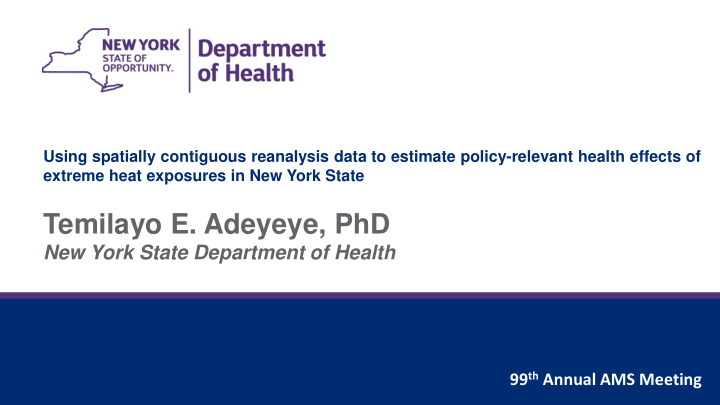



Using spatially contiguous reanalysis data to estimate policy-relevant health effects of extreme heat exposures in New York State Temilayo E. Adeyeye, PhD New York State Department of Health 99 th Annual AMS Meeting
January 23, 2019 2 Background • Global climate is changing rapidly with increasing variability in future temperatures and extreme weather events in most geographic regions (USGCRP, 2018) • Sparse surface weather observation stations in rural areas of NYS • Regional National Weather Service (NWS) heat advisory criteria in NYS were based on frequency of heat events estimated by sparse air monitor data ▪ USGCRP, 2018: Impacts, Risks, and Adaptation in the United States: Fourth National Climate Assessment, Volume II [Reidmiller, D.R., C.W. Avery, D.R. Easterling, K.E. Kunkel, K.L.M. Lewis, T.K. Maycock, and B.C. Stewart (eds.)]. U.S. Global Change Research Program, Washington, DC, USA. doi: 10.7930/NCA4.2018..
January 23, 2019 3 • The North American Land Data Assimilation System (NLDAS) derived from the North American Regional Reanalysis (NARR) datasets produce hourly meteorological parameters that can be used to calculate daily air temperatures, heat index and other extreme heat metrics at a 12-km spatial resolution
January 23, 2019 4 Objectives • To assess the effect of heat on health using fine- scale reanalysis data • To use our findings to better inform policies that protect the health of NYS residents during periods of extreme heat
5 Methods
January 23, 2019 6 Schema for Linkage of Analytic Datasets
January 23, 2019 7 Case Crossover Analysis …compared to Unusual activity Health your usual or exposure event routine? • Study of “triggers” within an individual • “Case” and “control” component, but information of both components will come from the same individual • “Case component” = hazard period which is the time period right before the disease or event onset • “Control component” = control period which is a specified time interval other than the hazard period
January 23, 2019 8 Threshold Analysis • Piecewise linear spline regression • Knots defining slope changes were sequentially selected at 5 ° F intervals • Trigger points – Minimum risk temperature (MRT) • For heat stress, MRT is defined as the lowest temperature at which the health outcome was observed during the study period. • For other outcomes, MRT is the lowest temperature above which a consistent increase in the relative risk was observed. – Excess risk temperature (ERT) • ERT is defined as the lowest temperature above the MRT at which the lower bound of the 95% confidence interval of relative risk of a particular health outcome was greater than 1.
9 Results
January 23, 2019 10 Risk of Hospitalizations/Emergency Department Visits for Selected Outcomes
January 23, 2019 11 Risk of Hospitalizations/Emergency Department Visits for Selected Outcomes
January 23, 2019 12 MRT ERT
January 23, 2019 13 Effect modification • Females were less likely to be hospitalized or visit the emergency room for dehydration-related health issues. • The risk for effects of heat exposure was highest on days with low ozone and high PM 2.5 and lowest on days with high ozone and low particulate matter exposures. • Rural areas of NYS are at as high a risk of heat-related illness as urban areas.
January 23, 2019 14 Discussion • Significant increased risk at lag 0 for heat stress and dehydration; and at lag 1 for renal diseases – Risk elevated up to 6-days before admission/ED visit • Marginal to non-significant increased risk for cardiovascular diseases hospitalizations/ED visits • Observed effects of heat can start at moderately high values of heat index much below current thresholds for NWS advisories
January 23, 2019 15
January 23, 2019 16 Strengths • Finer scale exposure data – Satellite data vs. air monitoring data • The use of a spatially contiguous exposure fields allows estimation of heat effects in small cities, rural and suburban areas that lack dense air monitoring networks • Case-crossover design – Useful in evaluation of short term changes in ambient temperature and risk of acute morbid events • Bias due to interindividual variation eliminated
January 23, 2019 17 Public Health Implications • Change in the heat advisory criteria for NYS – Effective June 1 st , 2018
January 23, 2019 18 Limitations • Use of residential addresses to assign exposure temperatures – Personal activities and exposure to indoor temperature not considered • Case-crossover design & same-day of the week referent selection help in minimizing bias • Lack of information on behavioral adaptations such air conditioning use, cooling centers etc.
January 23, 2019 19 Future Work • Assess the impact of lowering the heat advisory threshold on ED visits and hospitalizations for heat-related illnesses – Did the number of cases of heat-related illnesses reduce?
January 23, 2019 20 Acknowledgment • Estimating policy-relevant health effects of ambient heat exposures using spatially contiguous reanalysis data (Under Review at Environmental Health ) – NYSDOH : Tabassum Z. Insaf, Seema G. Nayak – NWS : Neil Stuart, Stephen DiRienzo – USRA : Mohammad Z. Al-Hamdan, William L. Crosson • Other Collaborators – NYSDOH: EPHT and BRACE grants – New York City Department of Health & Mental Hygiene : Sarah Johnson, Heather Glickman-Eliezer – Florida Department of Health : Chris DuClos, Melissa Jordan, Keisha Reid, Kristina Kintziger – Florida State University : Jihoon Jung, David Zierden – University of Alabama : Maury Estes – USRA : Muhammad Barik
January 23, 2019 21 QUESTIONS? Contact: Temilayo.Adeyeye@health.ny.gov This project is funded by NASA ROSES 2013: NNX15AN77G – Using Remote Sensing and Environmental Data to Quantify Social Vulnerabilities to Heat Stress and Strengthen Environmental Public Health Tracking and Heat Mitigation Efforts; supported by CDC’s National Environmental Public Health Tracking Program, Federal Award Number U38EH000942
Recommend
More recommend